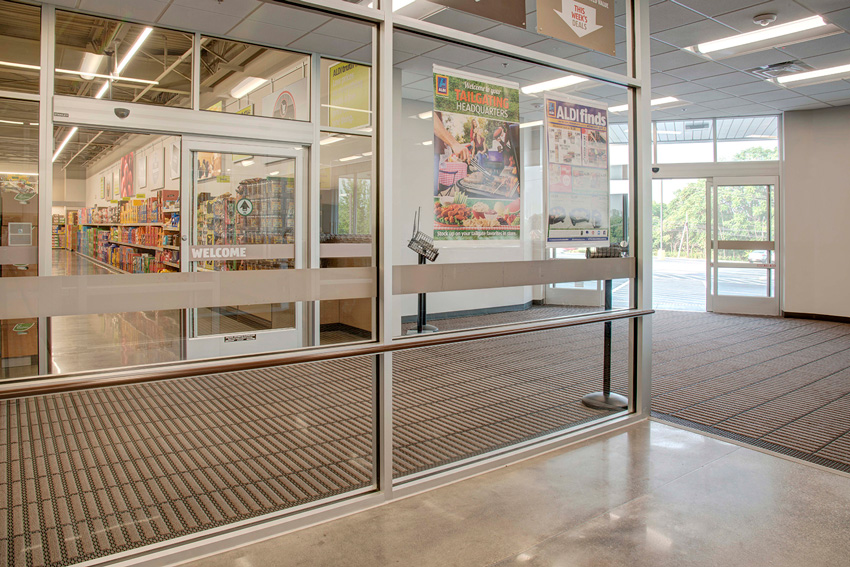Performance and Durability in Retail and Hospitality Design
Entrance Flooring Systems
The entrance into many hotel, restaurant, and retail spaces can receive a great deal of foot traffic that can leave floors wet, dirty, or even hazardous. That is the reason that many are equipped with a proper entrance flooring system that provides a secure, slip-resistant surface. It will also reduce the amount of dirt and moisture being tracked into the facility, creating a safer walking surface for customers and employees. It can also be specified in a variety of standard and custom finishes to contribute to the overall appearance of an entrance. As a result, it can protect people, increase the lifespan of interior products, enhance a brand, and redefine first impressions.
An increasingly popular version of entrance flooring is a modular, interlocking tile system made from recyclable, UV-resistant rubber and vinyl compound. This dimensionally stable tile will not shrink or create gaps while effectively scraping dirt and other debris from foot traffic. Some versions incorporate durable carpet strips that are available in multiple colors and are embedded into the top of the tiles. The interlocking tiles, commonly on the order of 12 by 9 inches, produce a tight, virtually seamless appearance creating a quiet, attractive, and durable system.
This type of entrance flooring system can be recessed into a floor slab or surface mounted since it is available in a thickness of less than ½ inch. That means it can be readily compliant with ADA or other accessibility standards. A framing system around the tile allows it to integrate seamlessly into a vestibule or transition to an adjacent floor covering. As a solid system, it can endure high volumes of foot traffic as well as a heavy rolling loads. It can be specified to be resistant to grease, chemicals, and abrasions for heavy-duty entrances. The large area for debris capture, the integrated scraper bars, and carpet inserts are powerful components that keep dirt and moisture trapped at the door to mitigate slips, trips, and falls, even in wet conditions. It can also be selected with a multidirectional walking surface for use in vestibules with multiple entry sides. When periodic maintenance is needed, it can be readily rolled up and out of the way.

Photo courtesy of Construction Specialties
Modular, interlocking, entrance flooring tiles with integral scrapers and carpet strips provide a safer, cleaner, and more attractive floor area at retail and hospitality entrances.
Gina Van Tine, AIA, LEED AP, of inForm Studios, finds that this type of modular entrance flooring works well for the firm’s projects, saying, “It gives us the assurance that our clients look for to help them maintain a clean sales floor even in the worst weather winter can dish up.” A growing grocery store chain concurs with this assessment. The store finds it to be an easy-to-install solution that keeps its busy interior floors clean and creates the right first impression for guests when they walk in through the doors. In fact, the store has coordinated a prestocking program that made ordering entrance flooring for the continuous store expansions and renovations a quick and simple process.
Effective Cooling and Heating Systems
Providing a comfortable environment in retail and hospitality facilities keeps occupants happy and can lead to increased time spent in the facilities, which is what the business owners want. Of course, they also want that comfort to come with low energy costs and flexibility in the way the system is designed and installed. Fortunately, there is a proven technology to meet all of these needs in the form of variable refrigerant flow (VRF) systems. When incorporated properly, VRF systems give retail and hospitality facilities highly efficient HVAC performance and provide occupants with exceptional comfort without it costing more. In fact, such systems can even save owners money through high energy efficiency, better control, and low maintenance.
Architects have occasionally faced resistance from building owners on these systems due to the owner’s lack of experience with or knowledge of VRF and the misperception that VRF is more costly. Therefore, it often becomes incumbent on the architects and engineers to help educate owners on the reasons to consider VRF, particularly in retail and hospitality spaces. The good news is that VRF has been in use globally for more than 35 years and is continuing to gain popularity in the United States because of the efficiency advantages and the ability to provide personalized comfort to occupants of many different building types. The flexibility of VRF systems allows building owners and architects to design spaces without having to compromise around the layout of a mechanical system.
Among the points to consider are the following:
- VRF is easier to design since it does not require long runs of ductwork and eliminates the need for large mechanical spaces.
- Compact outdoor equipment is easily transported in freight elevators, potentially eliminating the cost of cranes.
- VRF systems require minimal maintenance.
- Energy efficiency significantly reduces utility costs.
- VRF equipment typically lasts up to 20 years, reducing the expense of replacement.
- Space-zoning provides building occupants the ability to personalize their comfort, providing them with a very responsive thermal environment.
- Space-zoning capabilities also give building owners and facility managers the ability to turn off or set back systems in areas that are not occupied, further increasing savings.
- Life-cycle costs for VRF systems are also lower than generally thought. Ease of design and installation, minimal required maintenance, superior energy efficiency and long-lasting equipment contribute significant savings over the life of the system.
These savings and advantages are achieved through the basic engineering technology of the system that is energy efficient and flexible, helping retail and hospitality facilities meet their varied cooling and heating needs. Rather than inefficiently moving conditioned air to the spaces to be treated, VRF delivers refrigerant directly to those spaces and conditions the air within the space, providing better temperature control and the ability to treat zones independently.
VRF can also provide simultaneous cooling and heating from a single two-pipe system. Performance is further improved with inverter-compressor technology that uses the absolute minimum energy necessary to maintain comfort levels while adjusting to partial-load conditions, which are often the predominant state. Rather than inefficiently cycling on and off, VRF systems vary their speed to meet each zone’s conditioning requirements. Additional features like occupancy sensors and the ability to turn off areas that are not in use help further improve energy efficiency.

Photos courtesy of Mitsubishi Electric Cooling & Heating
Variable Refrigerant Flow (VRF) cooling and heating systems are ideal solutions for many retail and hospitality locations for both public and back of house spaces.
In addition to efficiently maintaining comfort, VRF systems provide some other notable design and performance benefits.
- Quiet operation: VRF technology uses compressors that quietly ramp up or down depending on the conditioning needs of each zone, thus eliminating the noisy on-and-off cycle of traditional HVAC systems. Indoor units minimize noise disruption by operating at low sound levels. Check manufacturers’ information, however, since noise levels can vary. Some of the best operate as low as 22 decibels (dBA) indoors with outdoor units operating as quietly at 56 dBA.
- Visually discreet: VRF systems are space-efficient and come in a variety of styles to blend into indoor and outdoor environments.
- Space saving: Compact system footprints give more usable space back to the building design, such as rooftop pools or social areas. No large runs of ductwork are needed, providing the option to increase ceiling height, add larger windows, or even fit additional floors within the same building envelope. Further, no large mechanical rooms are required, giving back more usable square footage for potential income generation.
- Design and system flexibility: Eliminating the need for bulky runs of ductwork makes VRF systems easier to design and modify as needed. Running piping for refrigerant is much more easily incorporated into designs for new or existing buildings. And if changes in the building are needed over time, it is similarly easy to modify or reconfigure systems or even to turn off sections in unoccupied spaces.
Overall, VRF systems are energy efficient and flexible, helping retail and hospitality facilities meet their varied cooling and heating needs. Kevin Miskewicz, director of commercial marketing at Mitsubishi Electric Cooling & Heating, has seen this first hand and points out, “VRF systems provide many benefits to building owners and occupants from personalized comfort to efficiency that significantly reduces energy consumption—and cost—over the life of the system. For architects, system flexibility gives them the freedom to design buildings to their vision without worrying about HVAC constraints.”
Conclusion
Retail and hospitality facilities need to be well designed in order to function well, look appealing to customers, provide comfort, and hold up against heavy use and even abuse. Achieving all of these objectives requires attention to the use of products, materials, and systems that can come together in design and performance in order to be successful. Using some or all of the strategies described in this article can help architects and designers achieve that success while owners and operators reap the long-term benefits.
Peter J. Arsenault, FAIA, NCARB, LEED AP, is a nationally known architect, consultant continuing education presenter, and prolific author advancing building performance through better design. www.pjaarch.com, www.linkedin.com/in/pjaarch

|

|

|

|

|
Notice

www.c-sgroup.com/acrovyn-by-design


MitsubishiPro.com

www.simonswerk-usa.com

www.special-lite.com









